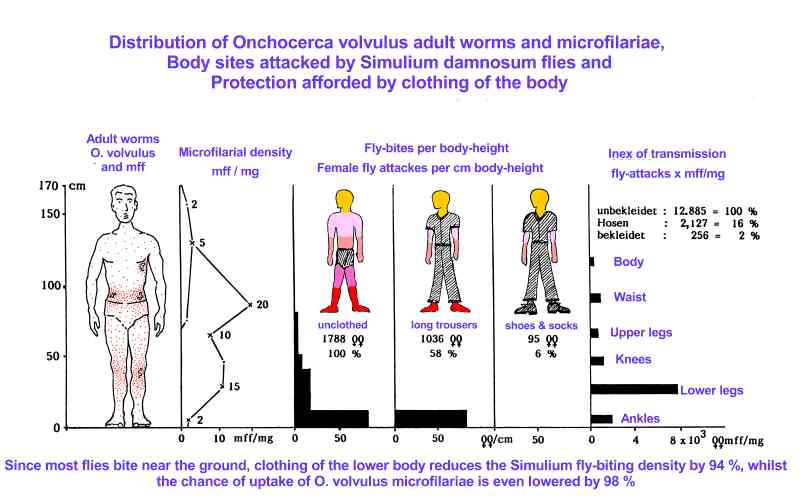Vector Control by Larvicides
Already in early 1950, Tauflieb successfully treated a Simulium breeding river in Northern Cameroon. However, these insecticide treatments (with DEET) were discontinued and had no lasting effect.
To be successful, the vector population would have to be eliminated for a duration of time, exceeding the life-expectancy of the parasite, which is about 10 to 15 years for the adult worms plus 1 to two years for the microfilariae in the skin. A duration of at least 20 years was therefore foreseen for the Onchocerciasis Control Programme in West-Africa, initiated by the WHO and funded by the World Bank and a number of funding agencies
The Onchocerciasis Control Programme of WHO in West-Africa
=> http://www.who.int/blindness/partnerships/onchocerciasis_OCP/en/index.htm
In the absence of a save drug to cure onchocerciasis, the World Health Organisation decided, with the help of the World Bank and a number of donor countries, to fight human riverblindness by attacking the Simulium vector flies, in order to interrupt transmission until the parasite reservoir has died out. This was done by regularly treating all Simulium damnosum s.l. breeding sites in the savanna area of the participation countries.
Abate (Temephos) was the first insecticide used, and, after resistance emerged, other chemicals were also used, including Bacillus thuringiensis (Bti-H14).
Very soon, a major problem turned up, which risked to jeopardize the whole Programme: During the rainy season, large numbers of old, parous and often O. volvulus L3-infected Simulium flies showed up in apparently well-controlled areas: The reinvasion problem. During the rainy season, the monsoon blows migration blood-fed female flies to northeren areas. The biological sense of this behaviour is to re-populate those fly-breeding sites, that had dried up during the preceding dry season.
This re-invasion phenomenon was intensely studied in the Eastern areas of the OCP, namely Togo and Benin (=> see WHO-OCP consultancy reports:
RENZ-Togo-1982-reinvasion-Simulium-Onchocerca,
RENZ-Togo-1983-reinvasion-Simulium-Onchocerca,
RENZ-Togo-1982-Extension-of-reinvasion-areas,
RENZ-Togo-1982-Morphological-criteria-Simulium-damnosum
Individual behaviour can drastically reduce exposure to transmission: A simple way to avoid human onchocerciasis.
=> Our own experiments in Cameroon
One very simple and easy to adapt method is to protect the lower limbs from the attacks of the Simulium flies: They tend to bite below the knees, mainly at the ankles:
sources: WHO, A. Renz; illustrations by Alfons Renz



Leave a Reply
Want to join the discussion?Feel free to contribute!